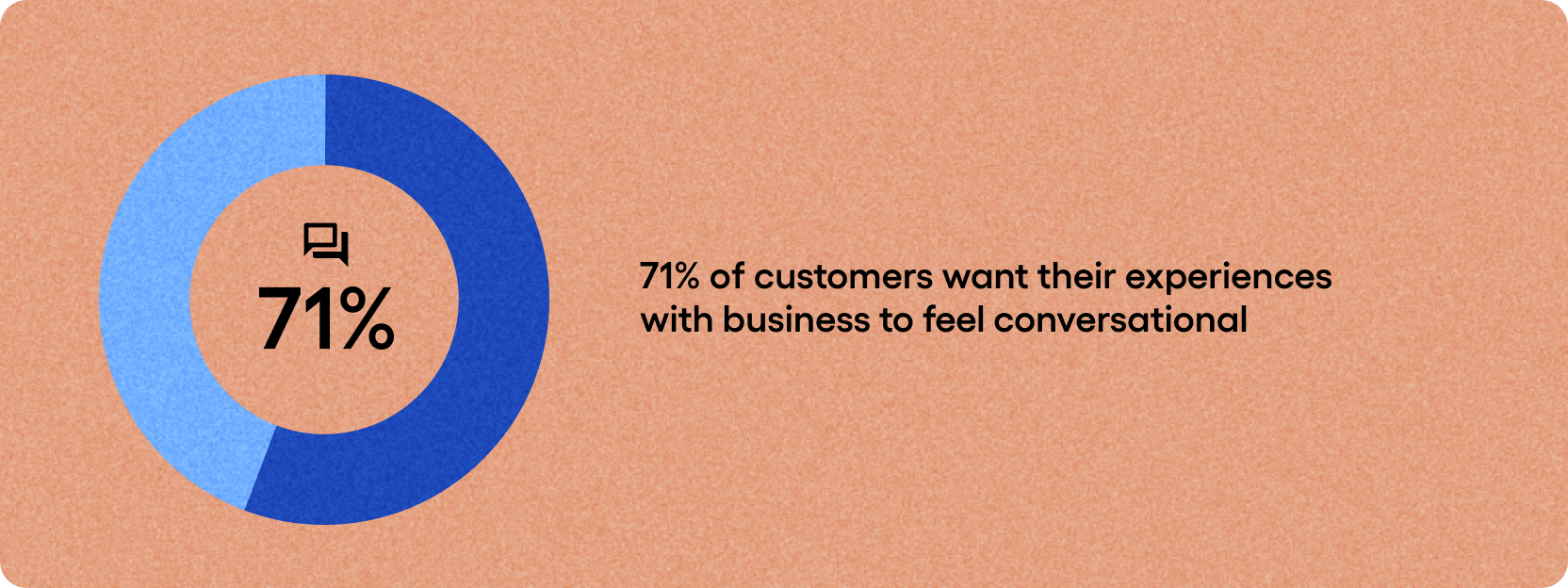How to make the most of customer communication apps

72% of customers expect immediate service from businesses when they need help.
This stat isn't too surprising. After all, we live in a highly-connected, always-on world.
What’s more intriguing is that a whopping 71% of customers want their experiences with a business to feel conversational.

In other words, they’re looking for seamless and non-disruptive interactions, no matter the platform, that unfold naturally within the applications they’re already familiar with.
There are several business benefits to putting a communication app at the center of the customer experience — mostly because of the power of customer conversations. For owners, managers, and the customer-facing teams that make businesses move, this guide will share everything you should know about creating a customer communication platform within your app.
What is a customer communication app?
A customer communication app is a tool that businesses can deploy to facilitate communication between customers and their teams.
These apps can take various forms. It can be compelling for app-based businesses to build customer communications into your app for the best experiences. Other companies may find that standalone, third-party communication platforms fit their audiences and goals.
No matter the execution, the ultimate goal remains the same: to make it easier for customers to contact your business with questions or concerns and for you to respond promptly to create solid and lasting relationships.
Why customer communication apps are critical to success
Boosting retention and recommendations, saving time and money as a result of more informed staffing and product development, and forging true connections with your target audience on their home turf are all benefits to developing a customer communication app. Let's dive into those ideas even further.
Engage customers and leads where they already are
When you consider the millions and even billions of users to bring into your product, it’s safe to assume that digital communication-based spaces are where a good percentage of your audience is already active.
This is why implementing a chat feature or Chat API into your app makes interactions easy for you and your audience. With Sendbird's UIKit, users are met with a messaging platform that feels familiar and is core to boosting engagement. It puts you in the right place at the right time.
Use this channel to stay top of mind with customized notifications about new products or services and personalized marketing pushes.
Measurability = Improvability
What can be measured can be managed — and improved.
With so many communication platforms having built-in analytics these days, it’s easier than ever to keep track of when users interact with your brand and what kinds of questions they have. This kind of information is critical to correctly staffing your customer support team, creating resources that help your customers get to the bottom of their questions painlessly, and even making product/service improvements that you know your customers will appreciate.
Inspire lasting business relationships
Using a customer communication app enables two-way communication between customers and your business, where they can express their thoughts and concerns essentially 24/7.
Opening your digital doors, so to speak, in this way gives insight into your brand identity and how deeply you value user input. This is crucial in creating mutually beneficial business-customer relationships that cement retention and referrals.
Rely on a proven in-app chat support solution that serves all industries
Provide smart and secure patient communication and care with HIPAA-compliant chat.
Increase conversions by delivering support at the point of need such as in the checkout process.
Reduce order cancellations with fast and real-time issue resolution when a ride or delivery goes wrong.
Improve student engagement and outcomes with personalized support for students and teachers alike.
Boost customer satisfaction and trust by making connections in real time and in context with your expertise.
Offer a faster and more convenient way for customers to ask questions or seek support with their financial account.
In-app communication vs. the third-party communication app
Regarding customer communication apps, businesses can create their in-app contact or rely on third-party communication platforms, such as WhatsApp and Facebook Messenger.
Both approaches have advantages and disadvantages, and choosing the right one can make a massive difference in user experience — which is why this is an essential factor to consider before moving on.
Let’s start with the idea of building customer communications right into your application. The most significant benefit is that this method provides users with the most seamless experience possible. They won’t need to switch between different apps to communicate with your team when they encounter problems or questions.
Additionally, in-app communication usually gives businesses much greater user experience control. It may also mean faster and more accurate responses when the team isn’t having to swap between different tools to get the job done.
On the other hand, third-party communication apps that exist separately from your app/website and the other software your team uses may grant you exposure to larger audiences, especially with platforms already widely used by consumers.
It may also be easier for businesses to integrate third-party communication apps into their workflow versus building an entirely new in-app communication feature from scratch.
This is where we’d like to inject an idea that enables businesses to take advantage of the best of both worlds: buy then build.
When you buy into a technology that’s committed to giving you the building blocks of a great experience and the freedom to personalize them in the best way for your business — you won’t only be set up to create better but also to create faster.
Next, let us show you how to buy-then-build your way into a powerful customer communication app.
Build robust communication in your app with Sendbird
Sendbird’s chat API (that’s application programming interface) allows brands to focus on their core offering and forget about all the complexities that come with creating a from-scratch communication interface.
Maintenance, rapid scaling, uptime, risk, edge cases, and uncontrollable costs? With a reliable communications API platform like Sendbird, these concerns are off the table, so you can ramp up development and reduce the time it takes you to get a fantastic customer experience to market.
Sendbird’s all-in-one chat platform has all the features you need to ensure your customers experience robust in-app communication with your team, including:
Messaging essentials like one-on-one and group chatting, notifications, reactions, audio, video, images, GIFs, file sharing, and more
Engagement features ranging from templates to admin messaging, scheduling, search, polls, and even built-in translation
Moderation tools such as automated moderation, a profanity and domain filter, blocking, banning, muting, reporting, spam protection, throttling, and beyond
Analytics capabilities that include an advanced dashboard as well as data export
Integrations with a chatbot interface and webhooks that make the functionality and the ability to work with your tech stack nearly endless
Want further to round out the communication experience within your app? You can do so easily with Sendbird’s voice and video API, pre-built live streaming user interface, and transactional and marketing notifications that cost less than SMS. You can also use Sendbird to create a unified inbox where customers can organize their interactions with your brand and a customer support dashboard that gives your agents the power to oversee and personalize the whole communication experience.
Developers can sign up to get started for free with Sendbird Chat’s approachable SDK, API, documentation, and demos. To compare features and get all the details on the cost of Sendbird’s products, check out our pricing page.
Five top third-party communication apps for business
With the growing popularity of third-party customer communication apps, businesses have more opportunities than ever to connect with consumers and leads.
But of course, not all apps are created equal, and choosing the right one for your business can be downright overwhelming.
So allow us to guide you through some top options based on popularity and power.
Viber for Business
With over a billion registered users as of 2020 from nearly 200 countries, Viber from Rakuten is a chat-focused, mobile-first app business that gives companies plenty of opportunities to connect with their customers worldwide.
Viber for Business is specially equipped to engage consumers with messaging and advertising solutions.
On the advertising front, businesses can place branded video and text ads throughout the Viber app, from the explore page to user profile pages, call feeds, chat feeds, and beyond. Branded stickers that Viber users can share within chats offer a unique outlet for natural-feeling advertisements.
As for messaging, businesses can choose chatbots that help automate lead qualification, conversions, and customer support. There is also a more classic messaging platform where companies can deploy their support folks to connect with customers and prospects via chat, allowing for text, images, file sharing, and even call-to-action buttons. This way, Viber is useful for purely conversational relationship building and transactional and promotional messaging.
Viber’s pricing is complex, with minimums and rates varying based on location. Check out their rate card to understand what you could spend using this platform for customer comms.
WhatsApp Business
WhatsApp, owned by Meta, is another mobile-first messaging platform with over 2 billion users across 180+ countries.
WhatsApp Business was explicitly created to help businesses meet customers who already hang out — in messaging apps — with personalizable experiences that accelerate the customer journey and encourage retention.
To that end, they’ve created two business paths: WhatsApp Business Platform and WhatsApp Business App.
The platform helps larger businesses integrate the WhatsApp experience into their existing technology via API. This connectivity level streamlines WhatsApp transactions through personalized marketing delivery, up-to-date product lists, purchasing capabilities, order confirmations and other pertinent notifications, and customer support automation.
The business-focused app was created for small businesses to enable owners and operators to communicate with customers on a more one-to-one basis. Users can complete a business profile with a catalog and checkout process. Messaging features include automated greetings, away messages, and shortcuts that help with frequently-asked questions. The platform also plugs into other Meta properties — Facebook and Instagram — with clickable ads that take leads straight to a WhatsApp store.
Pricing for WhatsApp Business appears to be based primarily on the number of daily conversations. For details, interested parties should contact their sales team.
Telegram
Telegram was one of the most downloaded apps of 2022 and has over 700 million monthly active users.
This unique messaging app is free to use at the basic level. Also, it features open APIs that developers can use to create bots that extend Telegram’s functionality and to build custom applications and clients on Telegram’s platform.
Telegram doesn’t have a tier specifically for business users, but there are a few key features that make it a great candidate as a customer communication application:
Privacy and security: Telegram uses what it refers to as “heavy” encryption to keep messages safe from nefarious activity.
Scalable comms.: Multimedia one-to-one chats and calls, as well as Groups and Channels, offer just about every size of communication channel businesses need to build relationships, share marketing materials, and provide support.
Powerful cross-platform capabilities: With apps in various desktop and mobile settings and real-time syncing to limitless devices, Telegram is a dream for businesses prioritizing quick customer communication.
Endless customization: With developer support, the above-mentioned Telegram APIs mean you can build all functionality into your Telegram instance — including an e-commerce flow.
Telegram is free, but frequent users may benefit from their premium package, which includes bigger file uploads, faster downloads, better chat features, and more. Pricing is location-based, and you can learn more about this subscription program from Telegram’s FAQ page.
Slack
With over 200,000 paying customers and daily active users across more than 150 countries, few people haven’t heard of Slack.
While Slack is typically considered an internal communication platform that helps teams stay connected and productive — there is a way to use this widely-adopted tool to support customer interactions.
Externally, Slack Connect is a feature that enables people and even organizations from outside of a company to participate in specific channels, moving communication from siloed email threads to a more collaborative environment.
Internally, customer support pros can use Slack to quickly find resources and connect with subject-matter experts to solve customer questions and issues and share feedback that contributes to product/service improvements.
Slack has several payment tiers, from free to enterprise plans, that can be customized and priced by working with their sales team.
Facebook Messenger
With almost 140 million users in the U.S. alone in 2022, Facebook Messenger is one the most well-known communication platforms on the planet, thanks to the popularity of Facebook — property of Meta — itself.
It’s safe to say that at least some of your business audience is on Facebook, so if you’re not engaging with Messenger occasionally, you’re likely missing out on some valuable opportunities.
In addition to the basic Messenger instance most of us have seen before, Meta has created a suite of tools for business-based messaging:
Inbox in Meta Business Suite: This tool is part of the Meta Business Suite and was built to help small and medium-sized organizations field communication from Facebook, Messenger, and Instagram Direct. Labels, assigning, saved replies, and auto-responses help businesses keep their inboxes under control. Messages that apply to orders and appointments can also be managed here.
Business Inbox in Messenger: The feature lives within Messenger and is for small businesses and public figures who receive a lot of communications privately in the Messenger app. There are fewer transaction-focused features here and more messaging-specific capabilities such as saved and automated replies, sponsored Messages, ads that connect to Messages, and a Messenger plugin for your website.
Messenger platform API: Large businesses and those with development resources can use this API to act on Facebook messages throughout their tech stack. For example, by connecting Messenger with their customer relationship management (CRM) platform, a business could use templates to respond to FAQs while also creating records of customers automatically and leads to follow up on in the future. If automation isn't enough, the API can also be set up to hand off questions to live agents. With development support, many interactions like these can be set up using the Messenger API.
It appears these features within Facebook Messenger are free to use. However, expect to spend if you engage in sponsored messages, advertisements, or API calls.
Apps that think about customer communication are the future
Speed is no longer enough — modern consumers demand conversation regarding a noteworthy brand experience.
Invest in Sendbird’s chat API to get the building blocks you can craft into a customer communication app that delivers.
Sign up to see if it’s right for your app and audience.






















